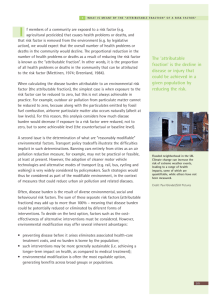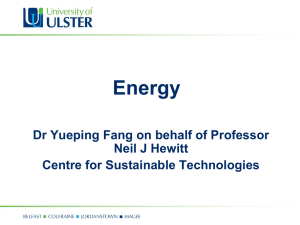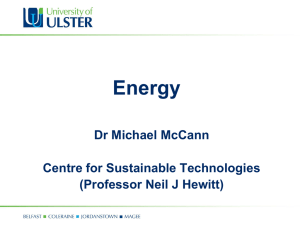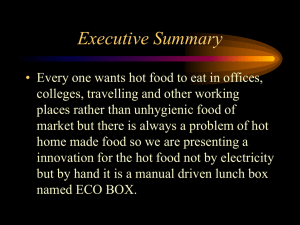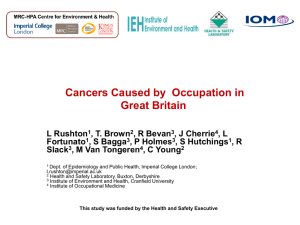Question 2
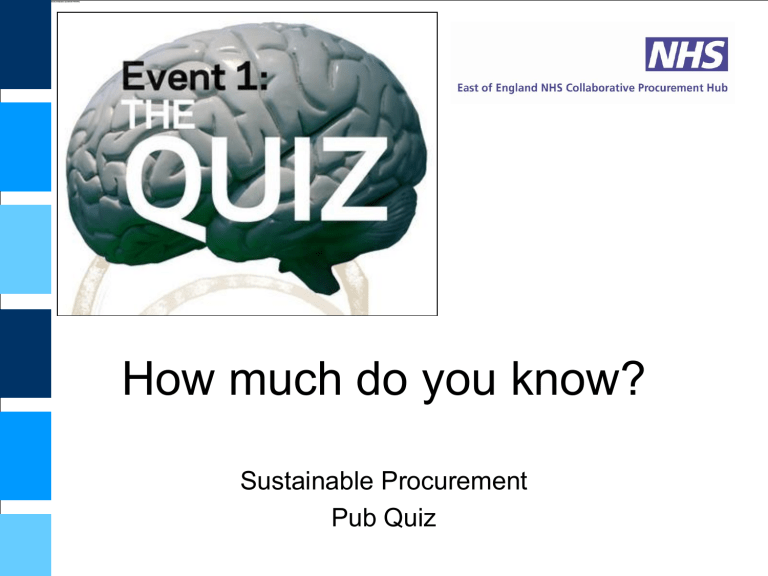
How much do you know?
Sustainable Procurement
Pub Quiz
How Much Do
You Know?
• Question 1: How much of the total energy used, over time, in the average video recorder in
Britain, is used while it is on standby?
A: Up to 15%
B: Up to 40%
C: Up to 60%
D: Up to 85%
The answer is D
In Britain, every year, £163m of electricity is used by TVs and videos on stand-by.
How Much Do
You Know?
• Question 2: The energy saved by recycling one aluminium drinks can is enough to run a TV for how long?
A: 30 minutes
B: One hour
C: Three hours
D: Ten hours
The answer is C
Recycling an aluminium can saves up to 95% of the energy needed to produce the amount of aluminium ore required to make a new one.
How Much Do
You Know?
• Question 3 :How much energy does a state-of-the-art energy efficient washing machine use compared to an old, inefficient one?
A: Two thirds less
B: Half as much
C: One third less
The answer is A
Energy efficient dishwaters cut energy use by nearly half and energy efficient tumble dryers cut it by a third.
How Much Do
You Know?
• Question 4: Which of the following are currently being used to generate electricity?
A: Human excrement and pig excrement
B: Chicken excrement and pig excrement
C: Chicken excrement and human excrement
D: Chicken, pig and
The answer is D human excrement
Electricity has been generated from human sewage sludge for decades, and Britain’s first animal dung-fired power station opened in 2002, using methane from pig, cow and chicken slurry to generate electricity.
How Much Do
You Know?
• Question 5: Biodiesel is a natural, renewable fuel which can be used in diesel engines – which of the following can it
A: Soya beans
B: Used chip fat
C: Carrots
D: Oilseed rape
NOT be made from?
The answer is C
Biodiesel can be made from most vegetable oils, including soya bean oil and the oil from oilseed rape
(canola). Some companies manufacture it from used oil from restaurant fryers. It can be mixed with ordinary diesel.
How Much Do
You Know?
• Question 6: The amount of energy poured onto the
Earth by the Sun every 15 minutes equivalent to what?
A: The world’s electricity needs for a decade
B: The world’s electricity needs for a year
C: The world’s electricity needs for a month
D: The world’s electricity needs for a day
The answer is B
How Much Do
You Know?
• Question 7: Hydrogen is a cleaner vehicle fuel than petrol and diesel, but electricity is needed to produce the hydrogen. If all
Britain’s vehicles were converted to run on hydrogen power, how many more nuclear power stations would be needed to generate the electricity?
A: 10
B: 50
C: 100
D: 500
The answer is C
How Much Do
You Know?
• Question 8: The heat energy stored in the uppermost 10km of the Earth’s crust is
A: 50,000
B: 500
C: 5 equivalent to how many times the total
D: 0.5 energy stored in all the world’s oil and gas? The answer is A
The temperature a few metres below ground in the UK is around 12C. "Ground source heat pumps" are now available to pump this heat from below ground to warm individual homes.
Remember...
• Climate change is happening quickly
• It has serious health consequences
• Urgent action has both immediate and long term benefits for health and the NHS
• Health professionals are trusted and have a duty to get educated, engaged and set an example by speaking out and acting on “the 21 st century’s most serious health challenge”
Environmental disease burden
•
Unsafe water and sanitation, poor hygiene. This environmental hazard is estimated to kill nearly 1.7 million people annually largely as a result of a range of waterborne diseases, including diarrhoeal diseases.
• Indoor air pollution. Associated with solid fuel use, mostly in poor countries. Globally,
1.5 million people died from diseases caused by indoor air pollution in the year 2002.
• Urban air pollution. Estimated to kill about 800k every year. Elevated levels of fine particulates in ambient air – typically emitted by vehicles, industry and energy generation – are associated with increases in daily and long-term premature mortality due to cardiopulmonary diseases, acute respiratory infections and cancers.
•
Climate change. Causes an estimated 150000 excess deaths annually, as well as injuries, from more extreme weather events such as heat waves, floods and droughts; impacts on regional food production; and changed transmission patterns of vector borne and other infectious diseases.
•
Lead exposure. Contributes to both childhood mental retardation and cardiovascular diseases associated with high blood pressure, together causing a loss of almost 13 million disability adjusted life years (DALYs - a combined measure of morbidity and premature mortality) annually, or nearly 1% of the global burden of disease.
Diseases with an important environmental contribution
•
Diarrhoeal diseases. Some 94% of the 1.8 million annual deaths from diarrhoeal disease is attributable to environmental causes, particularly unsafe drinking water and inadequate sanitation.
•
Lower respiratory infections. Over 1.5 million deaths annually from lower respiratory infections (41% of the LRI disease burden) are attributable to environmental factors, largely associated with exposure to indoor smoke from solid fuels and outdoor (ambient) air pollution.
• Vector-borne disease. Over 500000 deaths annually, or 42% of the global disease burden from malaria, are attributed to modifier able environmental factors such as poorlydesigned irrigation and water systems; poor housing and settlement sitting; deforestation and ecosystem change/degradation.
• Road traffic injuries. An estimated 467000 deaths from road traffic injuries, or about
40% of the total annual disease burden from traffic injury, is attributable to environmental factors, e.g. transport and land-use designs that expose pedestrians and cyclists to excessive risks.
•
Unintentional poisonings. Globally it is estimated that 71% of all unintentional poisonings, which kill about 350000 people annually, are attributable to environmental factors. In developing countries, such poisonings are strongly associated with poor chemical management in agro-industries and occupational settings.

